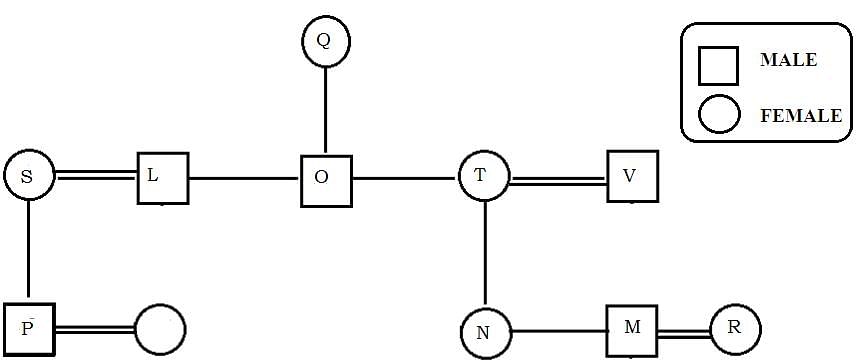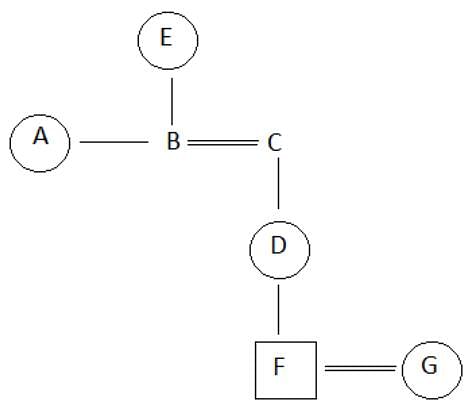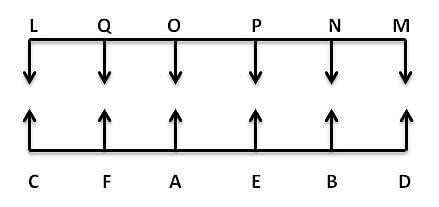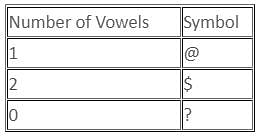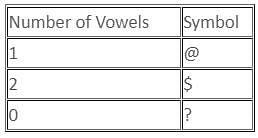SSC CGL (Tier II) Practice Test - 13 - SSC CGL MCQ
30 Questions MCQ Test - SSC CGL (Tier II) Practice Test - 13
Directions : Study the following information carefully and answer the questions given beside.
Virat kohli scored runs against different countries in three different years.
NOTE: Total runs scored in a year= Australia + England + Others
2015: The total runs scored in 2015 were 1200. The runs scored against England were 1/3rd of the runs against Others in 2016. The average runs scored against Australia and England was 300.
2016: The total runs scored against Australia and Others was 1200. The ratio of the total runs scored against Others in 2015 to that of the total runs scored against Others in 2016 is 4:3. The total runs scored against England in 2016 were equal to the total runs scored against England in 2017.
2017: The sum of the total runs scored against Australia and England is equal to the total runs scored against Others. The total runs scored in 2017 were 1400. The total runs scored against Australia were twice of the runs scored against England in 2015.
Q. What were the total runs scored in 2016?
Virat kohli scored runs against different countries in three different years.
NOTE: Total runs scored in a year= Australia + England + Others
2015: The total runs scored in 2015 were 1200. The runs scored against England were 1/3rd of the runs against Others in 2016. The average runs scored against Australia and England was 300.
2016: The total runs scored against Australia and Others was 1200. The ratio of the total runs scored against Others in 2015 to that of the total runs scored against Others in 2016 is 4:3. The total runs scored against England in 2016 were equal to the total runs scored against England in 2017.
2017: The sum of the total runs scored against Australia and England is equal to the total runs scored against Others. The total runs scored in 2017 were 1400. The total runs scored against Australia were twice of the runs scored against England in 2015.
Directions : Study the following information carefully and answer the questions given beside.
Virat kohli scored runs against different countries in three different years.
NOTE: Total runs scored in a year= Australia + England + Others
2015: The total runs scored in 2015 were 1200. The runs scored against England were 1/3rd of the runs against Others in 2016. The average runs scored against Australia and England was 300.
2016: The total runs scored against Australia and Others was 1200. The ratio of the total runs scored against Others in 2015 to that of the total runs scored against Others in 2016 is 4:3. The total runs scored against England in 2016 were equal to the total runs scored against England in 2017.
2017: The sum of the total runs scored against Australia and England is equal to the total runs scored against Others. The total runs scored in 2017 were 1400. The total runs scored against Australia were twice of the runs scored against England in 2015.
Q. What is the sum of the runs scored against England in all three years?
Virat kohli scored runs against different countries in three different years.
NOTE: Total runs scored in a year= Australia + England + Others
2015: The total runs scored in 2015 were 1200. The runs scored against England were 1/3rd of the runs against Others in 2016. The average runs scored against Australia and England was 300.
2016: The total runs scored against Australia and Others was 1200. The ratio of the total runs scored against Others in 2015 to that of the total runs scored against Others in 2016 is 4:3. The total runs scored against England in 2016 were equal to the total runs scored against England in 2017.
2017: The sum of the total runs scored against Australia and England is equal to the total runs scored against Others. The total runs scored in 2017 were 1400. The total runs scored against Australia were twice of the runs scored against England in 2015.
| 1 Crore+ students have signed up on EduRev. Have you? Download the App |
Directions: Study the following information carefully and answer the questions given beside.
Virat kohli scored runs against different countries in three different years.
NOTE: Total runs scored in a year= Australia + England + Others
2015: The total runs scored in 2015 were 1200. The runs scored against England were 1/3rd of the runs against Others in 2016. The average runs scored against Australia and England was 300.
2016: The total runs scored against Australia and Others was 1200. The ratio of the total runs scored against Others in 2015 to that of the total runs scored against Others in 2016 is 4:3. The total runs scored against England in 2016 were equal to the total runs scored against England in 2017.
2017: The sum of the total runs scored against Australia and England is equal to the total runs scored against Others. The total runs scored in 2017 were 1400. The total runs scored against Australia were twice of the runs scored against England in 2015.
Q. What is the difference between the total runs scored against Others in 2015 to the total runs scored against Others in 2016?
Virat kohli scored runs against different countries in three different years.
NOTE: Total runs scored in a year= Australia + England + Others
2015: The total runs scored in 2015 were 1200. The runs scored against England were 1/3rd of the runs against Others in 2016. The average runs scored against Australia and England was 300.
2016: The total runs scored against Australia and Others was 1200. The ratio of the total runs scored against Others in 2015 to that of the total runs scored against Others in 2016 is 4:3. The total runs scored against England in 2016 were equal to the total runs scored against England in 2017.
2017: The sum of the total runs scored against Australia and England is equal to the total runs scored against Others. The total runs scored in 2017 were 1400. The total runs scored against Australia were twice of the runs scored against England in 2015.
A car traveling with 5/7 of its actual speed covers 42 km in 1 hr 40 min 48 sec. What is the actual speed of the car?
In which year was the percentage of production of Company Z to the production of Company Y the maximum?
Read the information given below to answer these questions:
(i) Aarti is older than Sanya.
(ii) Muskan is elder than Aarti but younger than Kashish.
(iii) Kashish is elder than Sanya.
(iv) Sanya is younger than Muskan.
(v) Gargi is the eldest.
Q. Who is the youngest?
Read the information given below to answer these questions:
(i) Aarti is older than Sanya.
(ii) Muskan is elder than Aarti but younger than Kashish.
(iii) Kashish is elder than Sanya.
(iv) Sanya is younger than Muskan.
(v) Gargi is the eldest.
Q. Which of the given statements is/are superfluous and can be dispensed with while answering the above questions?
Statements: All men are vertebrates. Some mammals are vertebrates.
Conclusions:
- All men are mammals.
- All mammals are men.
- Some vertebrates are mammals.
- All vertebrates are men.
Directions: Read the following information and answer the question given below.
In a family of eleven, M is the son of O's mothers's daughter. Q is the mother of L and T. L and O are brothers. N is the daughter of T, who is the wife of V. P is the son of S, who is the daughter-in-law of Q. L is the father-in-law of P's wife. R is the daughter-in-law of V.
Q. Who is M's mother?
Question:
Among P, Q, R, S and T, Q is the second tallest and S is immediate taller than the shortest. Who among them is in the middle when they stand in the order of their heights?
Statements:
I. T is not the shortest.
II. R is taller than S but shorter than Q.
III. P ranks third in height above S when all are arranged in the order of height.
Directions: In this problem, the symbols ?, #, $, *, &, ^, % and @ are used with the meanings as illustrated below. Study the given information and answer the following question:
P ? Q → 'P is the mother of Q.'
P # Q → 'P is the child of Q.'
P $ Q → 'Q is the sibling of P.'
P * Q → 'Q is younger than P.'
P & Q → 'Q is the daughter of P.'
P ^ Q → 'P is the husband of Q.'
P % Q → 'P is the grandparent of Q.'
P @ Q → 'P is the sister-in-law of Q.'
Q. If E ? B * A @ C & D ? F ^ G, A $ B and the elder child of E is married, then who among the following is the granddaughter-in-law of C?
Directions: Read the following information carefully and answer the question that follows.
In a village of Bastar district in Madhya Pradesh, only two types of people live who belong to a tribal class. The first type is known as class A, while the other is known as class B. In that village, there is no other type of person except these two. The activities of both types of people are governed by perfectly patterned norms of social behaviour. Each person of the tribe has to obey the norms. They are rigid about this.
As far as marriage is concerned, the following norms are to be followed:
(A) The people of class A cannot marry any other member of their own class, though they can marry members of class B.
(B) After being married, each male member ceases to be member of that class in which he was born, but automatically he becomes the member of the other class to which his wife belongs.
(C) As far as females are concerned, they remain the members of their own class after being married.
(D) On its birth, the child automatically becomes the member of its mother's class.
(E) When any male member becomes widower or divorcee, then he again belongs to the group in which he was born.
(F) Nobody can marry more than one person according to social laws.
Q. A boy who was born in class B (boy and his wife both can have married and unmarried brothers) can have
Directions: Study the following information to answer the given questions
Twelve people are sitting in two parallel rows containing six people each, in such a way that there is an equal distance between adjacent persons. In row-1 L, M, N, O, P and Q are seated and all of them are facing South. In row-2 A, B, C, D, E and F are seated and all of them are facing North. Therefore, in the given seating arrangement each member seated in a row faces another member of the other row. O sits third to right of M. Either O or M sits at an extreme end of the line. The one who faces M sits second to right of E. Two people sit between B and F. Neither B nor F sits at an extreme end of the line. The immediate neighbor of B faces the person who sits third to left of L. N and P are immediate neighbors of each other. C sits second to the left of A. P does not face the immediate neighbor of D.
Q. Who amongst the following sit at extreme ends of the rows?
Directions: Read the following information carefully and answer the question given below.
A * B means A is to the left of B at a distance of 2 m.
A & B means A is to the west of B at a distance of 3 m.
A © B means A is to the south of B at a distance of 4 m.
A £ B means A is to the north of B at a distance of 3 m.
It is given that all the persons face north.
Q. If we have X * Y & G © D, then in which direction is D with respect to X?
Directions: Study the following information carefully and answer the question given below.
In a certain code language:
'fried pastry chef shape' is written as '15$W 18@B 12@U 15$V'.
'dough egg treat serve' is written as '15$S 9@T 15$G 15$V'.
'ball twist small sweet' is written as '12@O 15@G 15@O 15$G'.
'sour state own crypt' is written as '12$I 15$V 9@M 15?G'.
Q. What is the code for 'spy team lost'?
Directions: Study the following information carefully and answer the question given below.
In a certain code language:
'fried pastry chef shape' is written as '15$W 18@B 12@U 15$V'.
'dough egg treat serve' is written as '15$S 9@T 15$G 15$V'.
'ball twist small sweet' is written as '12@O 15@G 15@O 15$G'.
'sour state own crypt' is written as '12$I 15$V 9@M 15?G'.
Q. What will be the code for 'loud cry kid'?
Directions: Out of the given alternatives, choose the one which can be substituted for the given words/sentence.
People who belong to the same country
No sooner did I open the door / When the rain, heavy and stormy, rushed in / Making us shiver from head to foot / No error
Ancestors and dead relations were believed to punish…(11)… for sins, both of commission and …(12) …. . The ancestors were the guardians of….(13)…society’s morality, and they chastised those…..(14)…failed in their duty. The explanation….(15)..heard was: ‘He told lies about the ….(16)….and the ancestors killed him,’ or ’…(17).. uncle’s ghost killed him because he…(18)…. to look after his children or his…(19)… felt disgraced by his conduct, ….(20)…killed him’.
Q. Find the word most appropriate for Blank no. 13
Ancestors and dead relations were believed to punish…(11)… for sins, both of commission and …(12) …. . The ancestors were the guardians of….(13)…society’s morality, and they chastised those…..(14)…failed in their duty. The explanation….(15)..heard was: ‘He told lies about the ….(16)….and the ancestors killed him,’ or ’…(17).. uncle’s ghost killed him because he…(18)…. to look after his children or his…(19)… felt disgraced by his conduct, ….(20)…killed him’.
Q. Find the word most appropriate for Blank no. 19
DIRECTIONS: The following question contain an idiom followed by five possible meanings labelled A, B, C, D and E. Pick out the right meaning of the idiom and mark your answer accordingly.
Q.
To drive home
DIRECTIONS: The following question contains an idiom and its usage in a sentence, followed by five possible meanings labelled A, B, C, D and E. Pick out the right meaning of the idiom in question and mark your answer accordingly.
Q.
Plough a lonely furrow.
In the organised society of today no individual or nation can "plough a lonely furrow".
DIRECTIONS: The following question contains an idiom and its usage in a sentence, followed by five possible meanings labelled A, B, C, D and E. Pick out the right meaning of the idiom in question and mark your answer accordingly.
Q.
A far cry.
Inspite of world wide efforts, international peace is still "a far cry".
Directions: Read the following passage carefully and answer the questions given beside.
The second-largest colony of emperor penguins in the world appears to be collapsing, after rough seas drowned all of its babies three winters in a row.
The Halley Bay colony once accounted for 5 to 9% of the global emperor penguin population, according to the British Antarctic Survey (BAC), which reported the catastrophe. That amounted to about 15,000 to 24,000 adult breeding pairs. But in 2016, the sea-ice platform on which the colony was raising its babies collapsed during rough weather, throwing infant penguins unable to swim into the frigid water. In 2017 and 2018, the rough weather pattern repeated itself.
The birds arrive at the site from their summer sea jaunts each April to breed; for the resulting chicks to survive, the site has to remain stable throughout the Southern Hemisphere’s winter, which lasts until December.
By 2018, a handful of adults — a "few hundred," or about 2 percent of the original population — turned up at the Halley Bay site, the researchers reported. The remaining colony appeared in disarray, with adults moving closer to the ice edge than is typical, and was difficult to count scattered among the roughened chunks of ice.
The good news is that at least some of the colony appears to have moved, rather than died out. The Dawson-Lambton Glacier colony 34 miles (55 kilometres) to the south has significantly swelled in numbers since the devastation of Halley Bay, the BAC reported. That colony, which had hit a low of just 1,280 pairs in the 2015 season, swelled in each succeeding year. In 2016, it reached 5,315 pairs. In 2017, there were 11,117 pairs. And by 2018, a full 14,612 pairs set up camp at the site.
Q. Which of the following is false in the context of the passage?
I. The Dawson-Lambton Glacier colony died due to collapse of rough sea.
II. The penguin birds breed during April every year.
III. Halley Bay colony reached 5315 pairs in 2016.
Directions: The following question has two blanks. In each blank a preposition has been omitted. Choose the set of prepositions for each blank that best fits in the context of the sentence.
Several members of the film and theatre fraternity _______________ his house on Monday as well as on Tuesday morning to mourn his death.
I. Thronged
II. Flocked
III. Hosted
Which organization provided technical assistance for the development of guidelines for mountainous road infrastructure in India?
Which country recently became the 51st nation to agree to the Treaty of Amity and Cooperation (TAC)?
Choose the generation in which the microprocessor was first launched.
Which programming language is primarily used for database management and query processing?




